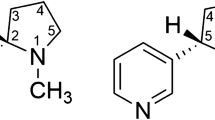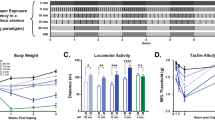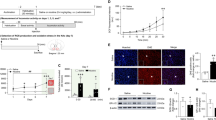Abstract
Although nicotine is generally considered to be the main compound responsible for the addictive properties of tobacco, experimental data indicate that nicotine does not exhibit all the characteristics of other abused substances, such as psychostimulants and opiates. For example, nicotine is only a weak locomotor enhancer in rats and generally fails to induce a locomotor response in mice. This observation contradicts the general consensus that all drugs of abuse release dopamine in the nucleus accumbens, a subcortical structure, and thus increase locomotor activity in rodents. Because tobacco smoke contains monoamine oxidase inhibitors (MAOIs) and decreases MAO activity in smokers, we have combined MAOIs with nicotine to determine whether it is possible to obtain a locomotor response to nicotine in C57Bl6 mice. Among 15 individual or combined MAOIs, including harmane, norharmane, moclobemide, selegiline, pargyline, clorgyline, tranylcypromine and phenelzine, only irreversible inhibitors of both MAO-A and -B (tranylcypromine, phenelzine, and clorgyline+selegiline) allowed a locomotor response to nicotine. The locomotor stimulant interaction of tranylcypromine and nicotine was absent in β2-nicotinic acetylcholine receptor subunit knockout mice. Finally, it was found that, whereas naïve rats did not readily self-administer nicotine (10 μg/kg/injection), a robust self-administration of nicotine occurred when animals were pretreated with tranylcypromine (3 mg/kg). Our data suggest that MAOIs contained in tobacco and tobacco smoke act in synergy with nicotine to enhance its rewarding effects.
Similar content being viewed by others
Log in or create a free account to read this content
Gain free access to this article, as well as selected content from this journal and more on nature.com
or
References
Balfour D, Benowitz N, Fagerstrom K, Kunze M, Keil U (2000). Diagnosis and treatment of nicotine dependence with emphasis on nicotine replacement therapy. A status report. Eur Heart J 21: 438–445.
Balfour DJ, Benwell ME, Birrell CE, Kelly RJ, Al-Aloul M (1998). Sensitization of the mesoaccumbens dopamine response to nicotine. Pharmacol Biochem Behav 59: 1021–1030.
Bates C, McNeill A, Jarvis M, Gray N (1999). The future of tobacco product regulation and labelling in Europe: implications for the forthcoming European Union directive. Tob Control 8: 225–235.
Belluzzi JD, Wang R, Leslie FM (2005). Acetaldehyde enhances acquisition of nicotine self-administration in adolescent rats. Neuropsychopharmacology 30: 705–712.
Berlin I, Said S, Spreux-Varoquaux O, Olivares R, Launay JM, Puech AJ (1995). Monoamine oxidase A and B activities in heavy smokers. Biol Psychiatry 38: 756–761.
Biala G, Langwinski R (1996). Rewarding properties of some drugs studied by place preference conditioning. Pol J Pharmacol 48: 425–430.
Breyer-Pfaff U, Wiatr G, Stevens I, Gaertner HJ, Mundle G, Marin K (1996). Elevated norharman plasma levels in alcoholic patients and controls resulting from tobacco smoking. Life Sci 58: 1425–1432.
Caggiula AR, Donny EC, White AR, Chaudhri N, Booth S, Gharib MA et al (2001). Cue dependency of nicotine self-administration and smoking. Pharmacol Biochem Behav 70: 515–530.
Caine SB, Lintz R, Koob GF (1993). Intravenous drug self-administration techniques in animals. In: Sahagal A (ed). Behavioural Neuroscience, Volume II: A Practical Approach. Oxford University Press: Oxford.
Carboni E, Silvagni A, Valentini V, Di Chiara G (2003). Effect of amphetamine, cocaine and depolarization by high potassium on extracellular dopamine in the nucleus accumbens shell of SHR rats. An in vivo microdyalisis study. Neurosci Biobehav Rev 27: 653–659.
Carr LA, Basham JK (1991). Effects of tobacco smoke constituents on MPTP-induced toxicity and monoamine oxidase activity in the mouse brain. Life Sci 48: 1173–1177.
Castane A, Valjent E, Ledent C, Parmentier M, Maldonado R, Valverde O (2002). Lack of CB1 cannabinoid receptors modifies nicotine behavioural responses, but not nicotine abstinence. Neuropharmacology 43: 857–867.
Champtiaux N, Gotti C, Cordero-Erausquin M, David DJ, Przybylski C, Lena C et al (2003). Subunit composition of functional nicotinic receptors in dopaminergic neurons investigated with knock-out mice. J Neurosci 23: 7820–7829.
Champtiaux N, Han ZY, Bessis A, Rossi FM, Zoli M, Marubio L et al (2002). Distribution and pharmacology of alpha 6-containing nicotinic acetylcholine receptors analyzed with mutant mice. J Neurosci 22: 1208–1217.
Charpantier E, Barneoud P, Moser P, Besnard F, Sgard F (1998). Nicotinic acetylcholine subunit mRNA expression in dopaminergic neurons of the rat substantia nigra and ventral tegmental area. Neuroreport 9: 3097–3101.
Corrigall WA, Coen KM (1989). Nicotine maintains robust self-administration in rats on a limited-access schedule. Psychopharmacology (Berlin) 99: 473–478.
Corrigall WA, Coen KM, Zhang J, Adamson L (2002). Pharmacological manipulations of the pedunculopontine tegmental nucleus in the rat reduce self-administration of both nicotine and cocaine. Psychopharmacology (Berlin) 160: 198–205.
Damaj MI, Martin BR (1993). Is the dopaminergic system involved in the central effects of nicotine in mice? Psychopharmacology (Berlin) 111: 106–108.
Dani JA, Heinemann S (1996). Molecular and cellular aspects of nicotine abuse. Neuron 16: 905–908.
Darracq L, Blanc G, Glowinski J, Tassin JP (1998). Importance of the noradrenaline-dopamine coupling in the locomotor activating effects of D-amphetamine. J Neurosci 18: 2729–2739.
Di Chiara G (2000). Role of dopamine in the behavioural actions of nicotine related to addiction. Eur J Pharmacol 393: 295–314.
Di Chiara G, Imperato A (1988). Drugs abused by humans preferentially increase synaptic dopamine concentrations in the mesolimbic system of freely moving rats. Proc Natl Acad Sci USA 85: 5274–5278.
Donny EC, Caggiula AR, Knopf S, Brown C (1995). Nicotine self-administration in rats. Psychopharmacology (Berlin) 122: 390–394.
Freeman GB, Sherman KA, Gibson GE (1987). Locomotor activity as a predictor of times and dosages for studies of nicotine's neurochemical actions. Pharmacol Biochem Behav 26: 305–312.
Fowler JS, Volkow ND, Wang GJ, Pappas N, Logan J, MacGregor R et al (1996a). Inhibition of monoamine oxidase B in the brains of smokers. Nature 379: 733–736.
Fowler JS, Volkow ND, Wang GJ, Pappas N, Logan J, Shea C et al (1996b). Brain monoamine oxidase A inhibition in cigarette smokers. Proc Natl Acad Sci USA 93: 14065–14069.
Fuller RW, Hemrick-Luecke SK, Perry KW (1988). Deprenyl antagonizes acute lethality of 1-methyl-4-phenyl-1,2,3,6-tetrahydropyridine in mice. J Pharmacol Exp Ther 247: 531–535.
Gaddnas H, Pietila K, Ahtee L (2000). Effects of chronic oral nicotine treatment and its withdrawal on locomotor activity and brain monoamines in mice. Behav Brain Res 113: 65–72.
Gerlach M, Riederer P (1996). Animal models of Parkinson's disease: an empirical comparison with the phenomenology of the disease in man. J Neural Transm 103: 987–1041.
Goldberg SR, Spealman RD, Goldberg DM (1981). Persistent behavior at high rates maintained by intravenous self-administration of nicotine. Science 214: 573–575.
Grimsby J, Toth M, Chen K, Kumazawa T, Klaidman L, Adams JD et al (1997). Increased stress response and beta-phenylethylamine in MAOB-deficient mice. Nat Genet 17: 206–210.
Heikkila RE, Manzino L, Cabbat FS, Duvoisin RC (1984). Protection against the dopaminergic neurotoxicity of 1-methyl-4-phenyl-1,2,5,6-tetrahydropyridine by monoamine oxidase inhibitors. Nature 311: 467–469.
Itzhak Y, Martin JL (1999). Effects of cocaine, nicotine, dizocipline and alcohol on mice locomotor activity: cocaine-alcohol cross-sensitization involves upregulation of striatal dopamine transporter binding sites. Brain Res 818: 204–211.
Kita T, Nakashima T, Shirase M, Asahina M, Kurogochi Y (1988). Effects of nicotine on ambulatory activity in mice. Jpn J Pharmacol 46: 141–146.
Klink R, de Kerchove d'Exaerde A, Zoli M, Changeux JP (2001). Molecular and physiological diversity of nicotinic acetylcholine receptors in the midbrain dopaminergic nuclei. J Neurosci 21: 1452–1463.
Koob GF (1998). Circuits, drugs, and drug addiction. Adv Pharmacol 42: 978–982.
Ksir C, Hakan R, Hall Jr DP, Kellar KJ (1985). Exposure to nicotine enhances the behavioral stimulant effect of nicotine and increases binding of [3H]acetylcholine to nicotinic receptors. Neuropharmacology 24: 527–531.
Langston JW, Irwin I, Langston EB, Forno LS (1984). Pargyline prevents MPTP-induced parkinsonism in primates. Science 225: 1480–1482.
Le Novere N, Zoli M, Changeux JP (1996). Neuronal nicotinic receptor alpha 6 subunit mRNA is selectively concentrated in catecholaminergic nuclei of the rat brain. Eur J Neurosci 8: 2428–2439.
Lefèvre P (1989). Pharmacologie des alcaloides mineurs du tabac. Sem. Hop. Paris 40: 2424–2432.
Li N, He S, Parrish C, Delich J, Grasing K (2003). Differences in morphine and cocaine reinforcement under fixed and progressive ratio schedules; effects of extinction, reacquisition and schedule design. Behav Pharmacol 14: 619–630.
Mansvelder HD, Keath JR, McGehee DS, Alkondon M, Albuquerque EX, Pereira EF et al (2002). Synaptic mechanisms underlie nicotine-induced excitability of brain reward areas. Neuron 33: 905–919.
Mansvelder HD, McGehee DS (2000). Long-term potentiation of excitatory inputs to brain reward areas by nicotine. Neuron 27: 349–357.
Manzardo AM, Stein L, Belluzzi JD (2002). Rats prefer cocaine over nicotine in a two-lever self-administration choice test. Brain Res 924: 10–19.
Marks MJ, Burch JB, Collins AC (1983). Genetics of nicotine response in four inbred strains of mice. J Pharmacol Exp Ther 226: 291–302.
Martellotta MC, Kuzmin A, Zvartau E, Cossu G, Gessa GL, Fratta W (1995). Isradipine inhibits nicotine intravenous self-administration in drug-naive mice. Pharmacol Biochem Behav 52: 271–274.
Mokry J (1995). Experimental models and behavioural tests used in the study of Parkinson's disease. Physiol Res 44: 143–150.
Nisell M, Nomikos GG, Hertel P, Panagis G, Svensson TH (1996). Condition-independent sensitization of locomotor stimulation and mesocortical dopamine release following chronic nicotine treatment in the rat. Synapse 22: 369–381.
Oreland L, Fowler CJ, Schalling D (1981). Low platelet monoamine oxidase activity in cigarette smokers. Life Sci 29: 2511–2518.
Picciotto MR, Zoli M, Lena C, Bessis A, Lallemand Y, LeNovere N et al (1995). Abnormal avoidance learning in mice lacking functional high-affinity nicotine receptor in the brain. Nature 374: 65–67.
Picciotto MR, Zoli M, Rimondini R, Lena C, Marubio LM, Pich EM et al (1998). Acetylcholine receptors containing the beta2 subunit are involved in the reinforcing properties of nicotine. Nature 391: 173–177.
Pidoplichko VI, DeBiasi M, Williams JT, Dani JA (1997). Nicotine activates and desensitizes midbrain dopamine neurons. Nature 390: 401–404.
Poindexter E, Carpenter R (1962). The isolation of harmane and norharmane from tobacco and cigarette smoke. Phytochemistry 1: 215–221.
Pontieri FE, Tanda G, Di Chiara G (1995). Intravenous cocaine, morphine, and amphetamine preferentially increase extracellular dopamine in the ‘shell’ as compared with the ‘core’ of the rat nucleus accumbens. Proc Natl Acad Sci USA 92: 12304–12308.
Rauhut AS, Mullins SN, Dwoskin LP, Bardo MT (2002). Reboxetine: attenuation of intravenous nicotine self-administration in rats. J Pharmacol Exp Ther 303: 664–672.
Risinger FO, Brown MM (1996). Genetic differences in nicotine-induced conditioned taste aversion. Life Sci 58: 223–229.
Rommelspacher H, Meier-Henco M, Smolka M, Kloft C (2002). The levels of norharman are high enough after smoking to affect monoamine oxidase B in platelets. Europ J Pharmacol 441: 115–125.
Robbins TW, Everitt BJ (1999). Drug addiction: bad habits add up. Nature 398: 567–570.
Shih JC (2004). Cloning, after cloning, knock-out mice, and physiological functions of MAO A and B. Neurotoxicology 25: 21–30.
Shoaib M, Gommans J, Morley A, Stolerman IP, Grailhe R, Changeux JP (2002). The role of nicotinic receptor beta-2 subunits in nicotine discrimination and conditioned taste aversion. Neuropharmacology 42: 530–539.
Shoaib M, Schindler CW, Goldberg SR (1997). Nicotine self-administration in rats: strain and nicotine pre-exposure effects on acquisition. Psychopharmacology (Berlin) 129: 35–43.
Smolen A, Marks MJ, DeFries JC, Henderson ND (1994). Individual differences in sensitivity to nicotine in mice: response to six generations of selective breeding. Pharmacol Biochem Behav 49: 531–540.
Sparks JA, Pauly JR (1999). Effects of continuous oral nicotine administration on brain nicotinic receptors and responsiveness to nicotine in C57Bl/6 mice. Psychopharmacology (Berlin) 141: 145–153.
Tassin JP, Vezina P, Trovero F, Blanc G, Herve D, Glowinski J (1992). Cortico-subcortical interactions in behavioral sensitization: differential effects of daily nicotine and morphine. Ann N Y Acad Sci 654: 101–116.
Uebelhack R, Franke L, Schewe HJ (1998). Inhibition of platelet MAOB by kavapyrone-enriched extract from Piper Methysticum Foster (kava-kava). Pharmacopsychiatry 31: 187–192.
Vezina P, Blanc G, Glowinski J, Tassin JP (1992). Nicotine and morphine differentially activate brain dopamine in prefrontocortical and subcortical terminal fields: effects of acute and repeated injections. J Pharmacol Exp Ther 261: 484–490.
Vezina P, Giovino AA, Wise RA, Stewart J (1989). Environment-specific cross-sensitization between the locomotor activating effects of morphine and amphetamine. Pharmacol Biochem Behav 32: 581–584.
Vezina P, Herve D, Glowinski J, Tassin JP (1994). Injections of 6-hydroxydopamine into the ventral tegmental area destroy mesolimbic dopamine neurons but spare the locomotor activating effects of nicotine in the rat. Neurosci Lett 168: 111–114.
Villégier AS, Blanc G, Glowinski J, Tassin JP (2003). Transient behavioral sensitization to nicotine becomes long-lasting with monoamine oxidase inhibitors. Pharmacol Biochem Behav 76: 267–274.
Villégier A, Salomon L, Granon S, Champtiaux N, Changeux J, Tence JJ et al (2004). Mice lacking the beta2 subunit of the nicotinic acetylcholine receptor are hyper-reactive to injection shock, opiates and psychostimulants. 2004 Abstract Viewer/Itinerary Planner, Program No. 238.10, Society for Neuroscience: Washington, DC, Online.
Wakasa Y, Takada K, Yanagita T (1995). Reinforcing effect as a function of infusion speed in intravenous self-administration of nicotine in rhesus monkeys. Nihon Shinkei Seishin Yakurigaku Zasshi 15: 53–59.
Yu PH, Boulton AA (1987). Irreversible inhibition of monoamine oxidase by some components of cigarette smoke. Life Sci 41: 675–682.
Zirkle CL, Kaiser C (1964). Monoamine oxidase inhibitors (non-hydrazines). In: Psychopharmacological Agents, I. Academic Press: New York. pp 474–475.
Acknowledgements
This work was supported by a fellowship from Fondation Gilbert Lagrue and by PHS Grant DA13332. We thank Luis Stinus for his advice on self-administration conditions.
Author information
Authors and Affiliations
Corresponding author
Rights and permissions
About this article
Cite this article
Villégier, AS., Salomon, L., Granon, S. et al. Monoamine Oxidase Inhibitors Allow Locomotor and Rewarding Responses to Nicotine. Neuropsychopharmacol 31, 1704–1713 (2006). https://doi.org/10.1038/sj.npp.1300987
Received:
Revised:
Accepted:
Published:
Issue date:
DOI: https://doi.org/10.1038/sj.npp.1300987
Keywords
This article is cited by
-
Effects of Monoamine Oxidase Inhibition on the Reinforcing Properties of Low-Dose Nicotine
Neuropsychopharmacology (2016)
-
Tobacco smoke containing high or low levels of nicotine during adolescence: effects on novelty-seeking and anxiety-like behaviors in mice
Psychopharmacology (2015)
-
Kinetic analysis of [11C]befloxatone in the human brain, a selective radioligand to image monoamine oxidase A
EJNMMI Research (2013)
-
Robust Escalation of Nicotine Intake with Extended Access to Nicotine Self-Administration and Intermittent Periods of Abstinence
Neuropsychopharmacology (2012)
-
A selective reversible monoamine oxidase B inhibitor in smoking cessation: effects on its own and in association with transdermal nicotine patch
Psychopharmacology (2012)



